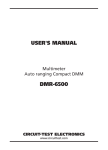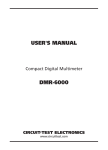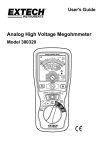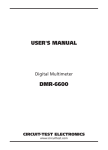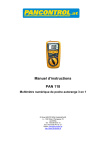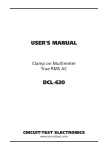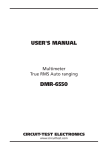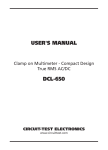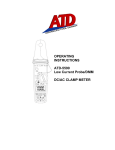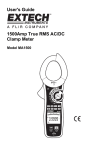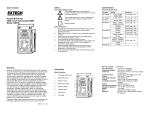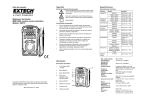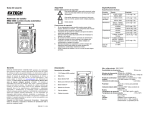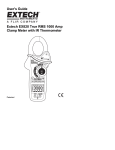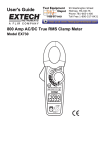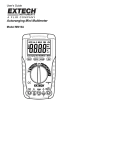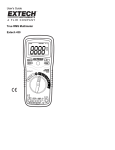Download USER`S MANUAL Multimeter Auto ranging Pocket
Transcript
Safety Specifications International Safety Symbols USER'S MANUAL This symbol, adjacent to another symbol or terminal, indicates the user must refer to the manual for further information. This symbol, adjacent to a terminal, indicates that, under normal use, hazardous voltages may be present. Multimeter Auto ranging Pocket DMM DMR-602 Double insulation This meter has been designed for safe use, but must be operated with caution. The rules listed below must be carefully followed for safe operation. Maximum Input V DC or V AC 600V DC/AC µA AC/DC 200mA/500V (fast acting resettable fuse) Resistance, Diode & Continuity Test 600V DC/AC 3. • 3-3/4 digit 4000 count LCD display • Built-in non-contact AC voltage detector • Flashlight • Double Molded housing • CATIV 600V 4. 5. 6. 7. Resistance Range & Resolution ±(0.8% rdg + 2digits) 4.000V, 40.00V ±(1.0% rdg + 5digits) 400.0V, 600V 400.0V, 600V 400.0µA, 4000µA 40.00mA, 200.0mA 400.0µA, 4000µA 40.00mA, 200.0mA ±(1.0% rdg + 2digits) ±(1.5% rdg + 5digits) ±(2.0% rdg + 2digits) ±(2.5% rdg + 5digits) 400.0Ω ±(0.8% rdg + 5digits) 40.00kΩ, 400.0kΩ ±(0.8% rdg + 2digits) 4.000kΩ, 4.000MΩ 40.00MΩ 4.000nF Capacitance Accuracy 400mV, 4.000V,40.00V 40.00nF 400.0nF, 4.000µF 40.00µF, 200.0µF ±(1.2% rdg + 5digits) ±(0.3% rdg + 5digits) ±(5.0% rdg + 5digits) ±(5.0% rdg + 0.6nF) ±(3.5% rdg + 30digits) ±(3.0% rdg + 20digits) ±(5.0% rdg + 30digits) Frequency 9.999Hz, 99.999Hz, 999.9Hz, 9.999kHz, ±(1.0% rdg + 2digits) Duty Cycle 0.5-99% ±(2.0% rdg + 5digits) SE EXTREME CAUTION when working with voltages greater than 25VAC U rms or 35VDC. These voltages are considered a shock hazard. Note: Accuracy specifications consist of two elements: • (% reading) This is the accuracy of the measurement circuit • (+ digits) This is the accuracy of the analog to digital converter Accuracy is stated at 65ºF to 83ºF (18ºC to 28ºC) < 75% RH LWAYS discharge capacitors and remove power from the device under test A before performing Diode, Resistance or Continuity tests. Non-Contact Voltage O NOT measure voltage if the voltage on the “COM” input jack exceeds 600V D above earth ground. EVER connect the meter leads across a voltage source when the function N switch is in the current, resistance or diode mode. LWAYS turn off the meter and disconnect the test leads from the circuit before A opening the cover to replace battery. ONLY operate the meter with the battery cover fastened securely. • 200mA/500V Resettable Fused current inputs and Diode Test Continuity Check Display Polarity Input Impedance Meter Description AC Response 1. Non-contact AC voltage detector probe tip Auto Power Off 2. Non-contact AC voltage indicator light 3. 3 3/4 Digit (4000 count) 4. MODE button 5. Function switch 6. Flashlight 7. Flashlight button 8. Hz/%Duty Cycle button 9. Battery Cover 10. Test leads 100 to 600VAC; 50/60Hz Test current 1mA, open circuit voltage of 1.5V DC typical Audible signal if the resistance is <100Ω 4000 count 3-3/4 digit LCD Over range indication “OL” is displayed Low Battery Indication • Overload protection on all ranges • Autoranging with auto power off DC Current Do not exceed the maximum rated input limits. Function 2. Features AC Voltage 50-60Hz AC Current 50-60Hz Input Limits www.circuittest.com DC Voltage Safety Precautions 1. CIRCUIT-TEST ELECTRONICS Function ACV Bandwidth Fuse Batteries Automatic; (-) sign for negative polarity. symbol indicates low battery condition. >7.5MΩ (VDC & VAC) Average responding 50Hz to 60Hz 15 minutes (approximately) mA, µA ranges; 0.2A/500V fast acting (resettable fuse) Two 1.5V AAA Operating Temperature 32ºF to 104ºF (0ºC to 40ºC) Storage Temperature Weight Size Safety / Approvals 14ºF to 122ºF (-10ºC to 50ºC) 0.319 lb (145g) 104x55x32.5mm (4.09”x2.1”x1.2”) This meter is UL and CUL approved and conforms to IEC61010-1 for Overvoltage Category CAT IV 600V. Operating Instructions WARNING: Risk of electrocution. High-voltage circuits, both AC and DC, are very dangerous and should be measured with great care. 3. Touch the test probe tips to the circuit or wire you wish to check. 4. If the resistance is less than approximately 100Ω, the audible signal will sound. If the circuit is open, the display will indicate “OL”. LWAYS turn the function switch to the OFF position when the meter is not in A use. This meter automatically shuts OFF after 15 minutes of inactivity. DIODE TEST 2. If “OL” appears in the display during a measurement, the value exceeds the range you have selected. Change to a higher range. 1. Set the function switch to the Ω 2. Press the MODE button to indicate 3. Touch the test probes to the diode under test. Forward voltage will typically indicate 0.400 to 0.700V. Reverse voltage will indicate “OL”. Shorted devices will indicate near 0V and an open device will indicate “OL” in both polarities AC/DC VOLTAGE MEASUREMENTS CAUTION: Do not measure AC/ DC voltages if a motor on the circuit is being switched ON or OFF. Large voltage surges may occur that can damage the meter. 1. Set the function switch to the position. 2. Press the MODE button to indicate “DC” or “AC” on the display. 3. ouch the black test probe tip to the negative side of the circuit. Touch the red T test probe tip to the positive side of the circuit. 4. Read the voltage in the display. For current measurements up to 4000μA C/DC, set the function switch to the position. 2. position. on the display CAPACITANCE MEASUREMENTS WARNING: To avoid electric shock, disconnect power to the unit under test and discharge all capacitors before taking any capacitance measurements. Remove the batteries and unplug the line cords. 1. Set the function switch to the Ω 2. Press the MODE button to indicate nF on the display. 3. Touch the test leads to the capacitor to be tested. 4. Read the capacitance value on the display. position. For current measurements up to 200mA AC/DC, set the function switch to the position. Set the function switch to the 2. Press the Hz/% button to display Hz on the display. 3. Touch the test probe tips to the circuit under test. 4. Read the frequency on the display. 5. Press the Hz/% button again to display % on the display. Press the MODE button to indicate “AC” or “DC” on the display. 6. Touch the test probe tips to the circuit under test. 4. emove power from the circuit under test, then open up the circuit at the point R where you wish to measure current. 7. Read the % duty cycle on the display. 5. ouch the black test probe tip to the negative side of the circuit. Touch the red T test probe tip to the positive side of the circuit. NON-CONTACT AC VOLTAGE MEASUREMENT 6. Apply power to the circuit and read the current in the display. RESISTANCE MEASUREMENTS WARNING: To avoid electric shock, disconnect power to the unit under test and discharge all capacitors before taking any resistance measurements. Remove the batteries and unplug the line cords. 1. Set the function switch to the Ω 2. Press the MODE button to indicate Ω on the display. 3. ouch the test probe tips across the circuit or part under test. It is best to disT connect one side of the part under test so the rest of the circuit will not interfere with the resistance reading. 4. Read the resistance in the display. position. WARNING: To avoid electric shock, never measure continuity on circuits or wires that have voltage on them. Set the function switch to the Ω Press the MODE button to indicate 2. Turn off the meter. 3. Remove the screw securing the battery cover at the bottom of the meter. 4. Replace the batteries observing the correct polarity. 5. Replace the cover and secure the screw. WARNING: To avoid electric shock, do not operate your meter until the battery cover is in place and fastened securely. RESETTABLE FUSE The resettable fuse (200mA/500V) will open if the current limits of the meter are exceeded and the fuse will automatically reset itself when the suspected current is removed from the meter’s input. LIMITED WARRANTY Circuit-Test Electronics warrants to the original purchaser that this product be free of defect in material or workmanship for a period of 2 years from the date of purchase. Any product which has been subjected to misuse or accidental damage is excluded from the warranty. Except as stated above, Circuit-Test Electronics makes no promises or warranties either expressed or implied including warranties of merchantability or the fitness for any particular purpose. WARNING: Risk of electrocution. Before use, always test the Voltage Detector on a known live circuit to verify proper operation. The Voltage Detector works with the function switch in any position including OFF. 1. ring the probe tip next to the hot conductor or insert into the hot side of the B electrical outlet. 2. If AC voltage is present, the detector light will illuminate. NOTE: NOTE: The conductors in electrical cord sets are often twisted. For best results, rub the probe tip along a length of the cord to assure placing the tip in close proximity to the live conductor. The detector is designed with high sensitivity. Static electricity or other sources of energy may randomly trip the sensor. This is normal operation FLASHLIGHT CONTINUITY CHECK 2. will appear in the display when the battery drops below the operating voltage and requires replacing. /HZ/% position. 1. 3. 1. 1. FREQUENCY/DUTY CYCLE MEASUREMENTS AC/DC CURRENT MEASUREMENTS 1. REPLACING THE BATTERY WARNING: To avoid electric shock, disconnect the test leads from any source of voltage before removing the battery door. 1. NOTE: On some low AC and DC voltage ranges, with the test leads not connected to a device, the display may show a random, changing reading. This is normal and is caused by the high-input sensitivity. The reading will stabilize and give a proper measurement when connected to a circuit. Maintenance position. on the display Press and hold the flashlight off. button to turn the flashlight on. Release the button to turn the AUTO POWER OFF The auto off feature will turn the meter off after 15 minutes. M-DMR-602 / 07R13



